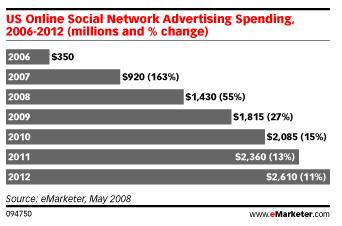
EMarketer feels it now has a better handle on social network ad spending for the more distant future, too. In 2011, it expects $2.4 billion to be spent versus its previous estimate of $2.7 billion.
Here are the reasons for the update to the previous report, which was published in December of 2007. A less rosy outlook on the economy will affect the amount of money spent by advertisers for years to come. Even the market leaders like Facebook and MySpace have yet to present compelling ad revenue models. Both companies, and others, have their own efforts to target advertising to users based on users’ demographic and personal information.
[aditude-amp id="flyingcarpet" targeting='{"env":"staging","page_type":"article","post_id":92411,"post_type":"story","post_chan":"none","tags":null,"ai":false,"category":"none","all_categories":"social,","session":"B"}']For those of us who think that social network application could partially prove their value through ads, the report now includes information on spending within social networking widgets and their more complex form, applications on Facebook and now other social networks. The fact that the forecast dropped in spite of this is not impressive.
AI Weekly
The must-read newsletter for AI and Big Data industry written by Khari Johnson, Kyle Wiggers, and Seth Colaner.
Included with VentureBeat Insider and VentureBeat VIP memberships.
Of course, television and newspaper ads aren’t necessarily more verifiable than social network ads, but advertisers are used to spending money on them. The bulls of social networking, like widget-maker Slide’s chief executive, Max Levchin, already see themselves as more engaging than television. But in order to prove themselves to advertisers on a large scale, they’ll need to bring better metrics to the table than traditional media can offer, and that proven forms of online advertising like search ads can even better offer.
EMarketer, in the meantime, expects to see social networks add new revenue from local advertising and automated social network ad sales.
And for those of us who wonder about whether or not Facebook is breaking even — and should need to be taking out $100 million loans for infrastructure — eMarketer says that it expects Facebook to make $265 million in ad revenue this year, below the previous $305 million projection. Note: The cost to an advertiser of creating branded applications on Facebook isn’t counted here
Of course, anyone reading about the report needs to remember that it doesn’t address other ways social networks make money, like e-commerce, that social networks and their applications are looking at closely.
VentureBeat's mission is to be a digital town square for technical decision-makers to gain knowledge about transformative enterprise technology and transact. Learn More
